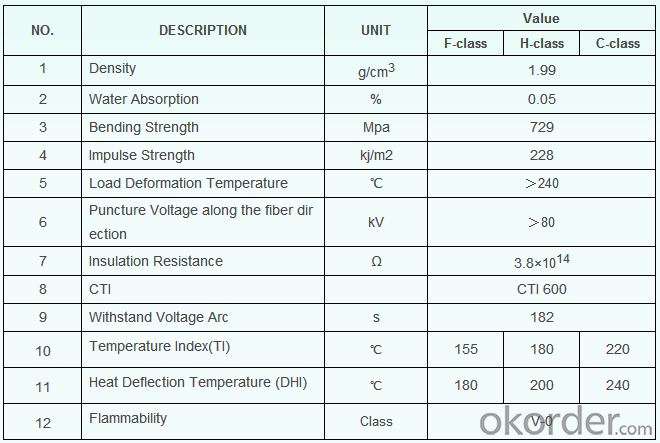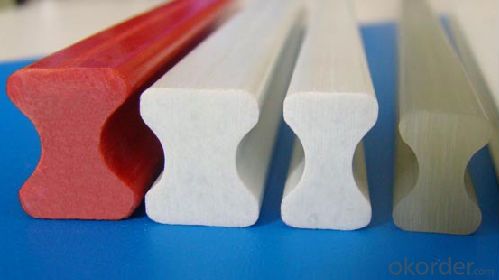Transformer And Electric Reactor Used insulation Dogbone
- Loading Port:
- Qingdao
- Payment Terms:
- TT or LC
- Min Order Qty:
- 10000 kg
- Supply Capability:
- 200000 kg/month
OKorder Service Pledge
OKorder Financial Service
You Might Also Like
1.Brief Introduction
Trasformer insulation parts series of our company mainly including insulation sheet,i-shape,corner piece and so on.It could be classfied as class F,H and C according to temperature resistant.We can produuce epoxy series,cinyl series and polyester series according to client's requirements.
2.Characteristics
Based on productive technology and long time experience.the advantages of our product as following
1)High mechanical strength.
2)High grade of temperature resistant.
3)Smooth and elegant surface
3.Technical Data Sheet


4.FAQ
a.Test Method:All the products have passed the full set of test.especially the related inspection of SGS.Our products have been sold to dozens of countries and regions,What is the most important.our products have passed all the technical inspections of most strict japanese clients.
b.Operative Norm:The operative norm of our product is JB/T10943-2010 "Brace used in Dry-type Transformer"and part of IEC60076.
c.New mold could be made according to customersrequirements.
- Q:Can FRP pultrusion profiles be used in automotive applications?
- Yes, FRP (Fiber Reinforced Polymer) pultrusion profiles can be used in automotive applications. FRP pultrusion profiles offer several advantages that make them suitable for automotive use. Firstly, FRP pultrusion profiles are lightweight yet strong, which is crucial in the automotive industry where reducing weight is a priority for improving fuel efficiency and performance. The high strength-to-weight ratio of FRP profiles allows for the design of lighter and more fuel-efficient vehicles. Secondly, FRP pultrusion profiles possess excellent corrosion resistance, which is important for automotive applications where exposure to various chemicals, moisture, and harsh environments is common. This resistance to corrosion ensures the long-term durability and reliability of the profiles, reducing maintenance costs and increasing the lifespan of automotive components. Additionally, FRP pultrusion profiles offer design flexibility, enabling the creation of complex shapes and geometries that can be customized to meet specific automotive requirements. This flexibility allows for the integration of FRP profiles in various automotive components, such as body panels, structural supports, interior trims, and suspension parts. Furthermore, FRP pultrusion profiles exhibit high fatigue resistance, which is crucial for automotive applications that involve repetitive loading and vibrations. The fatigue resistance of FRP profiles ensures their long-term performance and helps prevent failures and breakdowns. Lastly, FRP pultrusion profiles are electrically non-conductive, which is beneficial for automotive applications where electrical isolation is required. This property eliminates the need for additional insulation and reduces the risk of electrical failures and short circuits. Overall, the combination of lightweight, high strength, corrosion resistance, design flexibility, fatigue resistance, and electrical non-conductivity makes FRP pultrusion profiles suitable for various automotive applications, contributing to improved performance, fuel efficiency, durability, and safety in the automotive industry.
- Q:Are FRP pultrusion profiles resistant to vibration or shock?
- FRP pultrusion profiles exhibit high resistance to both vibration and shock. Their exceptional properties, inherent in FRP materials, make them an ideal choice for applications that demand durability and strength in the face of dynamic loading conditions. The composition of FRP profiles typically entails a combination of reinforcing fibers and a resin matrix, resulting in superb stiffness and damping characteristics. As a result, FRP pultrusion profiles effectively absorb and dissipate vibrations and shock forces, effectively preventing damage or degradation. Moreover, the design flexibility of FRP enables tailored reinforcement and optimization, further bolstering their ability to withstand vibration and shock. Consequently, FRP pultrusion profiles prove to be a dependable option for industries such as aerospace, automotive, marine, and structural engineering, where these properties are of utmost importance.
- Q:Can FRP pultrusion profiles be used in wastewater treatment facilities?
- Indeed, FRP pultrusion profiles have the capability to be utilized in wastewater treatment facilities. These profiles possess numerous benefits, including a high strength-to-weight ratio, resistance to corrosion, and durability, all of which make them highly suitable for the challenging conditions found in such facilities. In wastewater treatment facilities, there exists a wide range of applications where FRP pultrusion profiles can be effectively employed. These applications encompass walkways, handrails, ladders, grating, and structural supports, among others. The corrosion resistance of FRP makes it particularly well-suited for deployment in areas that are exposed to moisture and the chemicals present in wastewater. Furthermore, the lightweight nature of FRP profiles simplifies the installation process and reduces the burden placed on supporting structures. The durability of FRP pultrusion profiles guarantees long-term performance, even in aggressive environments. They exhibit a remarkable resistance to chemical attacks, UV radiation, and bacterial growth, rendering them highly appropriate for wastewater treatment applications. Additionally, FRP profiles can be tailored to meet specific load requirements and can be easily fabricated to accommodate various shapes and sizes. Furthermore, FRP pultrusion profiles possess outstanding electrical insulation properties, which can prove advantageous in wastewater treatment facilities where electrical safety is of utmost concern. To summarize, FRP pultrusion profiles can be effectively employed in wastewater treatment facilities due to their corrosion resistance, durability, lightweight nature, and versatility in terms of design and fabrication. These profiles provide long-lasting solutions for a variety of applications within these facilities, ensuring operational efficiency and minimizing maintenance needs.
- Q:Are FRP pultrusion profiles resistant to impact from flying debris?
- Yes, FRP pultrusion profiles are highly resistant to impact from flying debris. Thanks to their reinforced fiberglass construction, these profiles have exceptional strength and durability, making them capable of withstanding significant impact forces without incurring damage.
- Q:Can FRP pultrusion profiles be used in the construction of modular buildings?
- Modular buildings can utilize FRP (Fiber Reinforced Polymer) pultrusion profiles. These profiles possess various advantages that render them suitable for modular construction. To begin with, FRP pultrusion profiles are not only lightweight, but also highly durable and strong. This makes them perfect for modular buildings, where reducing weight is crucial for transportation and assembly. In fact, the strength-to-weight ratio of FRP pultrusion profiles often surpasses that of traditional construction materials like steel or concrete. Furthermore, these profiles are resistant to corrosion, chemicals, and weathering. This becomes particularly significant for modular buildings, as they may face different environmental conditions during transportation and on-site assembly. The corrosion resistance also guarantees the longevity and durability of the modular building. Moreover, FRP pultrusion profiles can be designed to possess excellent thermal insulation properties. This proves advantageous for modular buildings that prioritize energy efficiency, as it helps minimize heating and cooling costs. Additionally, these profiles are easily shaped and customized to meet the specific requirements of the modular building design. This versatility allows for the creation of intricate and complex structural components, thereby facilitating the modular construction process. Furthermore, FRP pultrusion profiles are non-conductive, which enhances safety in modular buildings. Their inability to conduct electricity makes them appropriate for applications necessitating electrical insulation. In conclusion, FRP pultrusion profiles offer a viable choice for constructing modular buildings due to their lightweight, durability, corrosion resistance, thermal insulation properties, versatility, and non-conductive nature. These attributes make FRP pultrusion profiles a reliable and efficient solution for modular construction projects.
- Q:Can FRP pultrusion profiles be used in aerospace applications?
- Yes, FRP (Fiber Reinforced Polymer) pultrusion profiles can be used in aerospace applications. These profiles offer a combination of strength, lightweight, and corrosion resistance, making them suitable for various aerospace components such as structural supports, fairings, and interior panels. Additionally, FRP pultrusion profiles have high fatigue resistance and can withstand extreme temperatures, enhancing their suitability for aerospace use.
- Q:Are FRP pultrusion profiles resistant to hydrochloric acid?
- FRP pultrusion profiles are generally resistant to hydrochloric acid. The corrosion resistance of FRP (Fiber Reinforced Polymer) materials varies depending on the specific resin and fiber used in the manufacturing process. However, most FRP pultrusion profiles are designed to withstand exposure to a wide range of chemicals, including hydrochloric acid. The corrosion resistance of FRP is attributed to the chemical inertness of the resin matrix, which is typically made of polyester, vinyl ester, or epoxy. These resins provide a protective barrier against chemical attack and allow FRP profiles to maintain their structural integrity even in harsh environments. That being said, the level of resistance can vary depending on the concentration and temperature of the hydrochloric acid. In highly concentrated or elevated temperature conditions, the resistance may be reduced. It is always advisable to consult the manufacturer's specifications or seek expert advice to ensure the suitability of FRP pultrusion profiles for specific acid concentration and temperature ranges. Overall, FRP pultrusion profiles are known for their excellent chemical resistance, and they are often chosen for applications where exposure to acids or corrosive environments is expected.
- Q:Can FRP pultrusion profiles be used in the telecommunications industry?
- Yes, FRP pultrusion profiles can be used in the telecommunications industry. They offer numerous advantages such as high strength-to-weight ratio, corrosion resistance, electrical insulation properties, and design flexibility. These profiles can be used for applications such as antenna radomes, cable trays, equipment enclosures, and support structures.
- Q:Can FRP pultrusion profiles be used in the water and wastewater treatment industry?
- Yes, FRP (Fiber Reinforced Polymer) pultrusion profiles can be used in the water and wastewater treatment industry. FRP pultrusion profiles are highly durable, corrosion-resistant, and have excellent mechanical properties, making them suitable for various applications in the water and wastewater treatment industry. One of the main advantages of FRP pultrusion profiles is their resistance to corrosion. Water and wastewater treatment facilities often deal with aggressive chemicals, high humidity, and corrosive environments. Traditional materials like steel or wood may deteriorate and require frequent maintenance or replacement. However, FRP pultrusion profiles are specifically designed to withstand harsh conditions without corrosion, ensuring long-term performance and reducing maintenance costs. Additionally, FRP pultrusion profiles offer excellent strength-to-weight ratio, making them ideal for structural applications in water and wastewater treatment facilities. They can be used as walkways, handrails, grating, ladders, and other structural components. The lightweight nature of FRP profiles allows for easy installation and minimizes the load on the supporting structures. Furthermore, FRP pultrusion profiles are non-conductive, providing an added safety benefit in water and wastewater treatment facilities. This property is particularly important when dealing with electrical equipment or applications near water sources, reducing the risk of electrical hazards. Moreover, FRP pultrusion profiles can be customized to meet specific design requirements, including different shapes, sizes, and colors. This flexibility allows for greater design freedom, ensuring that the profiles can be tailored to fit the specific needs of water and wastewater treatment projects. Overall, the use of FRP pultrusion profiles in the water and wastewater treatment industry offers numerous advantages, including corrosion resistance, high strength, lightweight, non-conductivity, and design flexibility. These qualities make FRP profiles a reliable and cost-effective choice for various applications in this industry.
- Q:What are the best manufacturers of glass fiber reinforced plastic pultruded profiles in China?
- In addition to the thickness of radome products, there should be other requirements.
1. Manufacturer Overview |
|
|---|---|
| Location | |
| Year Established | |
| Annual Output Value | |
| Main Markets | |
| Company Certifications | |
2. Manufacturer Certificates |
|
|---|---|
| a) Certification Name | |
| Range | |
| Reference | |
| Validity Period | |
3. Manufacturer Capability |
|
|---|---|
| a)Trade Capacity | |
| Nearest Port | |
| Export Percentage | |
| No.of Employees in Trade Department | |
| Language Spoken: | |
| b)Factory Information | |
| Factory Size: | |
| No. of Production Lines | |
| Contract Manufacturing | |
| Product Price Range | |
Send your message to us
Transformer And Electric Reactor Used insulation Dogbone
- Loading Port:
- Qingdao
- Payment Terms:
- TT or LC
- Min Order Qty:
- 10000 kg
- Supply Capability:
- 200000 kg/month
OKorder Service Pledge
OKorder Financial Service
Similar products
New products
Hot products
Related keywords






























